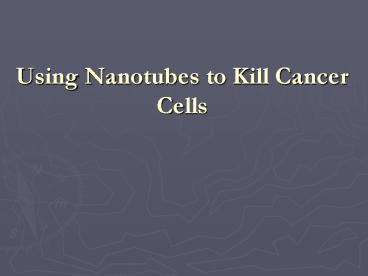Using Nanotubes to Kill Cancer Cells - PowerPoint PPT Presentation
1 / 11
Title:
Using Nanotubes to Kill Cancer Cells
Description:
Single-walled nanotubes (SWNTs) were used in this experiment. Preparation of Nanotubes ... Infrared Range, but Single Walled Carbon Nanotubes absorb light in ... – PowerPoint PPT presentation
Number of Views:73
Avg rating:3.0/5.0
Title: Using Nanotubes to Kill Cancer Cells
1
Using Nanotubes to Kill Cancer Cells
2
General Idea of Experiment
- Nanotube rods were inserted into cancerous cells
in a solution that contained both cancerous and
normal cells - A laser in the Near Infrared Range (? 700 to
1100 nm) was shone on the solution the cancer
cells heated up to 70 degrees Celsius and died - The normal cells were fine biological tissue is
transparent to NIR light.
3
Carbon Nanotubes
- Cylindrical Carbon molecules that have very
useful properties. - For example, they are incredibly strong.
- Able to absorb light at near infra-red
wavelengths (700-1100 nm). - The name comes from the size of the nanotubes
(their width is on the order of a few
nanometers). - Thousands of nanotubes can fit in a single cell.
- Single-walled nanotubes (SWNTs) were used in this
experiment.
4
Preparation of Nanotubes
- Nanotubes were mixed with a solution of DNA. The
DNA contained a fluorescent label called Cy3 - DNA strands wrapped around the nanotubes
- Phospholipid molecules were added to the ends of
the DNA strand to allow them to be accepted by
the cancer cells.
5
Temperature Evolution of SWNT-DNA Solution
(ex-vitro)
- Control experiment 808 nm light at 1.4 W/cm2
shone on solution of DNA- wrapped Nanotubes. - The temperature of the solution rose by about 50
oC in 2 minutes.
6
Transfer of Nanotubes into Living Cells
T 37 oC
T 4 oC
7
Shine a Light
8
Targeting Cancer Cells
- Unlike normal cells, the surfaces of the cancer
cells contained numerous receptors for a vitamin
called folate. - Phospholipids that were attached to folic acid
molecules were added to the ends of the DNA
strands. - This caused the nanotubes to be accepted into
diseased cells with folate receptors (FR). - There are many other possible ways to target
specific cells for example attaching an
antibody to a nanotube to go after a particular
type of diseased cell.
9
(No Transcript)
10
Summary of Results
- One of the main challenges with curing cancer is
the problem of killing normal cells along with
cancer cells in treatment. - This is what causes people to lose their hair and
suffer other side-effects. - Biological material is transparent to light in
the Near Infrared Range, but Single Walled Carbon
Nanotubes absorb light in this range and re-emit
the energy as heat. - Tagging nanotubes with specific molecules allows
them to enter only diseased cells. Light can
then be shone on a mixture of diseased and
healthy cells, killing only the diseased cells.
11
References
- http//news-service.stanford.edu/news/2005/august1
0/nanotube-081005.html - http//en.wikipedia.org/wiki/Carbon_nanotube
- http//www.stanford.edu/dept/chemistry/faculty/dai
/group/Reprint/96.pdf - http//www.tipmagazine.com/tip/INPHFA/vol-10/iss-1
/p24.pdf - http//www.repairfaq.org/sam/laserhen.htm































